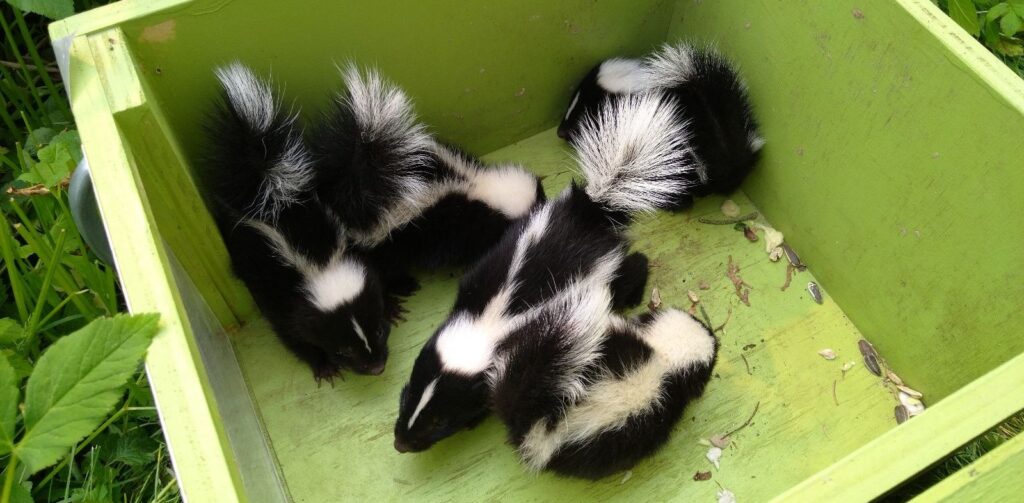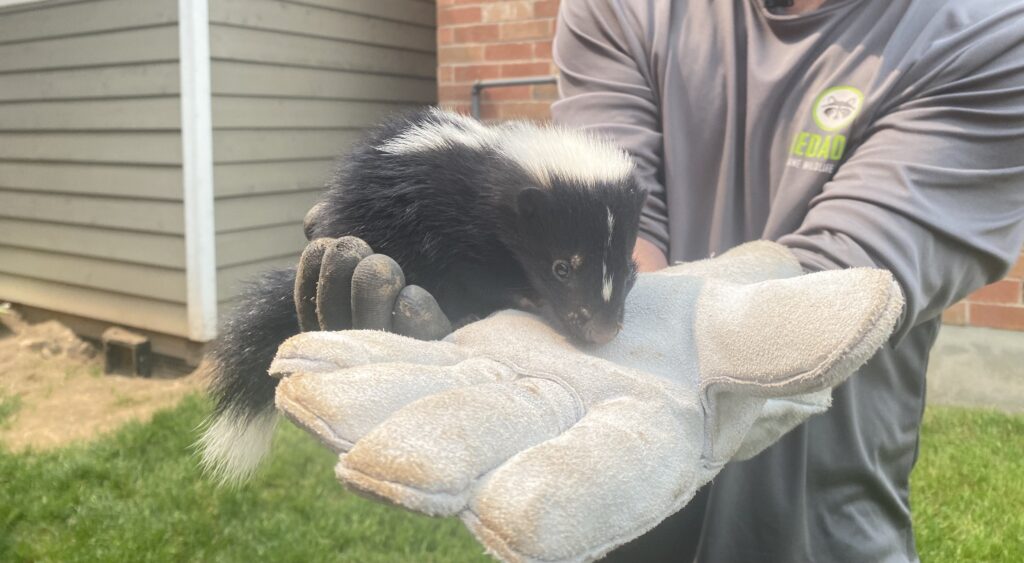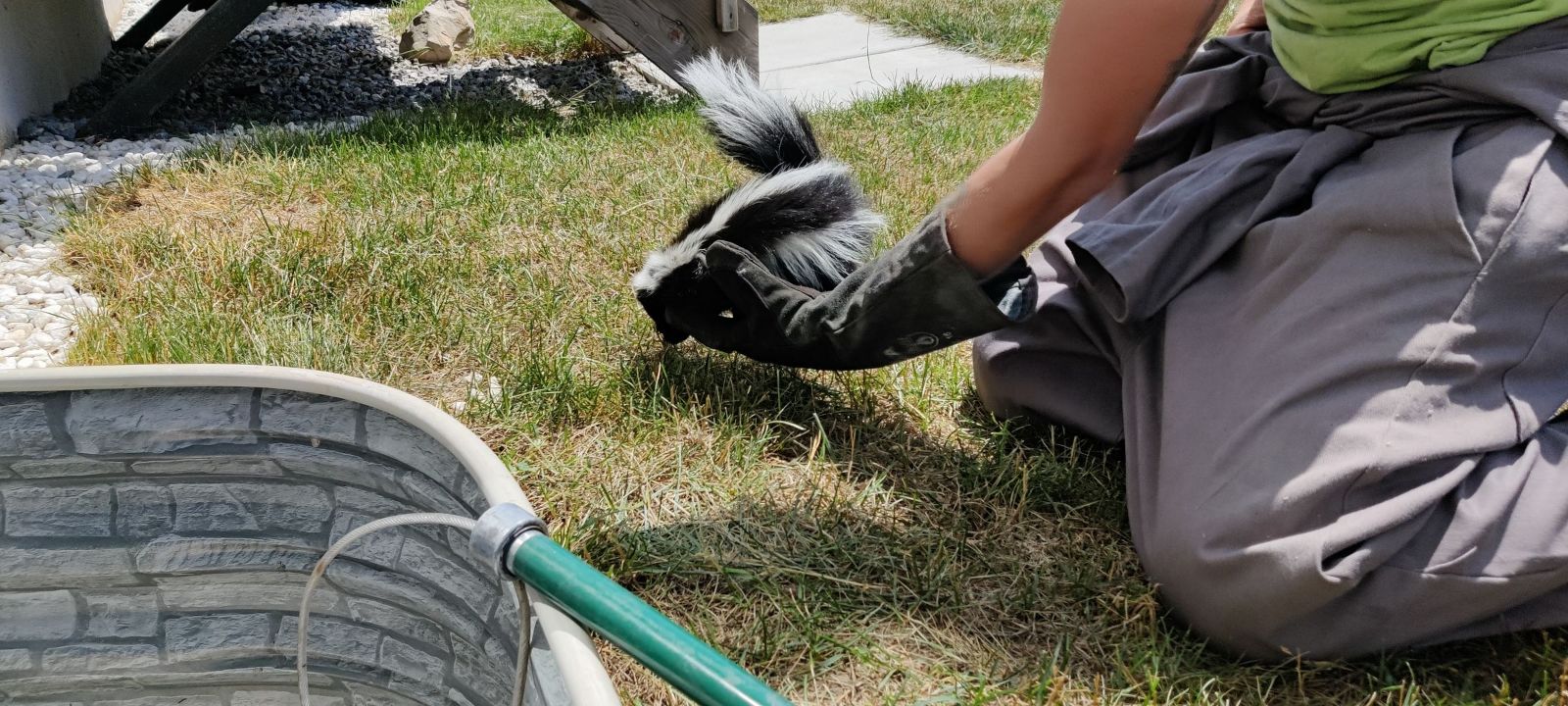Skunks, often noted for their distinct black-and-white colouring and their unique defence mechanism, are creatures of fascination and, sometimes, concern, especially when they decide to make their homes in residential areas of Mississauga. The curiosity around these animals peaks during the skunk mating season, a period filled with heightened activity and the inevitable question from homeowners discovering skunks in their yards: How many babies will they have? Understanding skunk reproduction patterns is key to managing their presence around your home and garden.
Skedaddle Humane Wildlife Control specializes in the humane management and removal of skunks and other wildlife from residential areas in Mississauga. We often encounter questions about skunk families, especially regarding their size and how to handle the sudden appearance of skunks on a property.
Typically, a female skunk will give birth to a litter containing anywhere from two to ten babies, with the average number being around four to six. Our services include not just wildlife removal in Mississauga but also the long-term protection of properties. With high-quality materials and workmanship, we are able to offer our clients a lifetime guarantee.
Breeding Habits and Impact on Local Populations
Skunks are not only known for their unique defence mechanisms but also for their distinctive breeding habits, which can significantly influence their population in residential areas. Our experience at Skedaddle Humane Wildlife Control has shown that understanding these habits is crucial for homeowners looking to coexist peacefully with local wildlife.
The mating season for skunks typically stretches from late winter to early spring. During this period, skunks become more active, and their search for mates can lead them closer to human habitation. This increased activity is often when homeowners notice a surge in skunk sightings around their properties. The gestation period for skunks lasts about two months, leading to the birth of litters in the late spring to early summer. A single season can see a female skunk giving birth to one litter consisting of two to ten kits, with four to six being the most common range.
Understanding these reproductive cycles is essential for homeowners who find themselves playing host to these creatures. While our focus at Skedaddle is on humane approaches to managing wildlife interactions, recognizing the signs of skunk reproduction can inform the best times for preventative measures. This knowledge helps avoid unintentional disturbances to skunk families, which can lead to defensive behaviour.

The Early Life: From Birth to Independence
Following the birth of a skunk litter, the early weeks of a skunk kit’s life are a time of rapid development and maternal care. These initial stages are crucial as the kits are born blind, deaf, and entirely dependent on their mother for warmth, protection, and nourishment. The first weeks see the skunk kits nursing and staying within the safety of the den, under the watchful eye of their mother. Around the age of three weeks, their eyes open, marking a significant milestone in their development.
As the kits grow, their adventurous spirit begins to manifest. By the time they are two months old, they start venturing out of the den on short excursions to explore their surroundings and learn essential survival skills from their mother. This period is often when homeowners might notice young skunks around their property, as these exploratory outings can lead kits into residential areas in search of food or play.
It’s during these early forays that the kits begin practicing their famous defensive spray, though it’s less potent than the adults. The kits continue to grow and learn under their mother’s guidance throughout the summer, reaching independence at around three to four months old. At this point, they are capable of surviving on their own, and the family group disperses.
The presence of skunk kits exploring nearby can be a charming sight, yet it’s a reminder of the importance of living harmoniously with our local wildlife. By understanding the growth and development stages of skunk kits, homeowners can appreciate the natural cycle of these often misunderstood creatures and the reasons behind their behaviours. Recognizing these signs can also guide when to take gentle measures, if necessary, to encourage them to find habitats away from human dwellings without disrupting their natural development.
Nesting in Mississauga Yards: A Closer Look
The cozy corners of our Mississauga neighbourhoods, including under decks, sheds, and porches, often become chosen nesting sites. These areas provide skunks with a perceived safe haven from predators and the elements, making residential yards an attractive option for these creatures. Furthermore, the abundance of food sources present in our yards, from pet food left outside to accessible garbage cans and gardens, acts as a magnet for skunks. Their presence in our spaces is not by accident but a result of the inviting environment we unknowingly offer.
Detecting the occupancy can be fairly straightforward, evidenced by their distinctive odour, sightings of foraging at dusk or dawn, and holes in your yard as they search for grubs and insects. Another telling sign is the damage to lower garden plants. . These indicators not only signal their presence but also hint at the reasons behind their choice of nesting sites.
Effective Strategies for Deterrence and Safety
Skunks, while an essential part of our ecosystem, can become unwelcome guests when they decide to take up residence in our yards. Understanding how to manage these encounters can ensure both the safety of our families and the humane treatment of skunks. Here, we will explore several methods to discourage skunks from nesting in areas where they are not wanted and highlight the role of professional assistance in these situations.
Exclusion Techniques
One of the most effective ways to prevent skunks from making a home on your property is through exclusion. Securing potential entry points such as holes under decks, and sheds with sturdy materials can deter a skunk from nesting.
Modifying the habitat around your property plays a crucial role in making the environment less appealing to skunks. Removing food sources by securely covering trash bins, not leaving pet food outside, and limiting access to water sources can greatly reduce the attractiveness of your space to these animals.
The Importance of Professional Assistance
While DIY methods can be effective, certain situations call for the expertise of professional wildlife services. Professionals possess the knowledge to identify and seal off potential nesting sites properly, preventing future occurrences.
Resolving skunk visits is about balance – ensuring the safety and comfort of your home while respecting the natural behaviour of wildlife. Professionals can guide homeowners in achieving this balance, making our coexistence with skunks peaceful and respectful.
Our Comprehensive Approach to Managing Unwanted Animal Guests
At the heart of our service is a thorough and considerate approach to ensuring your living spaces remain harmonious and free from unwelcome animal visitors. From the initial assessment of your property to the final stages of fortifying your home against future visits, our team is committed to delivering solutions that are not just effective but are done so with the utmost respect for the animals and the environment.
Initial Assessment and Identification
Our process begins with a careful evaluation of your property, where we can identify the signs of animal activity and figure out the best course of action. Our expertise in animal behaviour allows us to understand the nuances of each situation, guiding our strategy in a way that is specific to the needs of your home and the animals involved.
Humane Handling and Removal
We prioritize humane methods in handling animals, ensuring they are treated with care throughout the removal process. Our team is skilled in installing one way doors, helping animals leave their dens, but preventing them from re-entering. This can help lead them to a suitable environment where they can thrive without causing disturbance to homeowners.
Preventive Measures and Fortification
The final step in our approach focuses on prevention — securing your home against future invasions. We advise on and implement modifications to your surroundings, such as sealing entry points or altering habitat conditions, to discourage animals from returning. This proactive stance ensures long-term peace of mind for you and your family.
Choosing our professional services brings a host of benefits, including deep knowledge of animal behaviour, ethical treatment practices, and compliance with local regulations. We understand the importance of resolving these issues with sensitivity and precision, aiming to restore your home to a place of safety and tranquillity.
Making Your Home Less Inviting to Skunks: Practical Tips
Creating an environment that discourages skunks from visiting or nesting near your home is essential for a peaceful coexistence. By focusing on eliminating food sources and minimizing shelter opportunities, homeowners can significantly reduce the likelihood of skunks choosing their property as a nesting site. Here are some practical tips to help you achieve this:
- Feed Pets Indoors: Try to avoid leaving pet food outside, especially overnight. Skunks are nocturnal and are more likely to visit when they find easy access to food.
- Remove Water Sources: Limit access to pools, bird baths, or any open water containers, as these can attract skunks looking for hydration.
- Maintain a Clean Yard: Keep your yard free of debris and fallen fruits, and eliminate dense vegetation or piles of wood where skunks could find shelter.
- Install Gravel Borders: These creatures dislike digging through gravel. Creating gravel borders around your home, deck, or garden can deter them from digging and nesting.
While these tips can significantly reduce the chances of skunks visiting or nesting near your home, ongoing vigilance and occasional support from our professionals can ensure that these measures remain effective.

Effective Wildlife Removal in Mississauga During Skunk Mating Season
In summary, understanding skunk reproduction behaviours and their potential impact on local residents is crucial for managing encounters and preventing them from establishing nests in undesired areas. Skunk mating season can lead to increased sightings and activities in yards, posing challenges for homeowners in Mississauga.
Our professional wildlife control services offer significant advantages in addressing these challenges. By employing humane and ethical removal techniques alongside preventive measures, we effectively mitigate the issues caused by skunks and other wildlife. Our comprehensive approach ensures that homeowners can enjoy peace and safety, maintaining a respectful coexistence with local wildlife.
Our role in providing effective, humane solutions for wildlife issues, particularly during the critical periods of mating season, distinguishes our services. We are dedicated to ensuring that your encounters with skunks and other wildlife are handled with the utmost care and professionalism, emphasizing the importance of ethical treatment and preventive strategies.
For homeowners in Mississauga experiencing challenges with skunks in their yards or looking for proactive measures to prevent wildlife issues, we invite you to request an estimate to learn more about how our services can restore tranquility to your home and surroundings.




